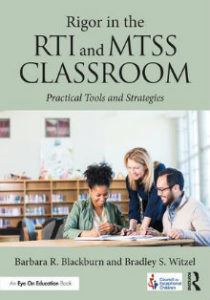What It Means to Have Rigor in RTI Classrooms
Rigor in the RTI and MTSS Classroom: Practical Tools and Strategies
By Barbara R. Blackburn and Bradley S. Witzel
(Routledge, 2018 – Learn more)

Identifying and implementing effective RTI practices is definitely easier said than done. Across the country, there is a push to meet students on both their academic and emotional-behavioral levels. Without a clear-cut outline for effective strategies to implement in the classroom, there will not be much movement, for the better, with today’s learners.
Response to Intervention, or RTI, is an emphasis “on interventions in order to curb a student’s lower performance” (pg. 4). Essentially, RTI is the ‘how’ and the ‘what’ behind focused, intentional instruction that is designed to support students before they fall into the failure bracket. MTSS, which stands for Multi-tiered System of Supports, is designed to affect students at multiple levels, from core content to secondary and intensive interventions. (See this MiddleWeb article.)
There is more to RTI than just offering additional help sessions or retest opportunities. For RTI to be effective, there needs to be a specific approach to the implementation of help strategies and instructional interventions and how they are implemented.

The introduction includes a frank assertion as to “why” RTI and MTSS is important for educators to implement: impacting the high school dropout rate and assuring that we are truly preparing students to be college and career ready when they do graduate. RTI provides educators with immediate and focused interventions, interventions that impact all students at all grade levels.
Easy to access guidance
The book has an extensive table of contents with logically organized topics and subtopics which makes it a simple tome to navigate in order to find the most relevant information to make implementation as easy as possible. One of the best features of the text is the matter-of-fact section on the misconceptions about rigor (pg. 13). One important thing to remember is that just because a question is difficult to answer, does not mean it indicates one has a rigorous classroom.
An example to this is the typical scenario where a student has not memorized a fact, so they are unable to answer a test question. This does not make the assessment rigorous, just difficult. For rigor to be involved, students must be required to use higher order thinking skills and analysis as part of the learning process.
The authors do an excellent job of clearly defining the tiers of rigor, as well as creating an implementation matrix (pg. 19) to explain what this would look like in the classroom.
Ideas to effective assessment
Assessing the impact of effective RTI and MTSS is explored, in depth, and there is deep discussion about the difference between formative and summative assessment and how to use assessments to assist with RTI and MTSS implementation.
Peppered within the book are mini ‘pause and reflect’ sections that do cause the reader to stop and think about how this would look in own their classroom, in contrast to the examples given. Occasionally there are graphics and examples of what a teacher can create in order to work with the RTI tiers in the classroom.
Towards the end of the book is an entire chapter about how to implement the effective RTI and MTSS practices from administration down. There are sections and subsections on identifying and implementing an RTI and MTSS team, and ideas of how to determine who would be best-suited to fulfill certain roles.
Essentially, this book is a “how to” and a “why bother” concerning the identification and implementation of effective RTI and MTSS practices. The focus is always about meeting students where they are, in ways that impact their retention and graduation success.
Blackburn and Witzel’s text gives practical advice on how to implement change in the classroom, grade level, school, and district wide. There are no special materials needed in order to help students reach their fullest potential; rather, this text assures educators that they have the knowledge and power to affect change as they follow best practices.
Erin Corrigan-Smith is a middle school ELA teacher in a suburb of Atlanta. She has a B.A. and M.A. in English, and her focus of study is children’s literature. During the school year she is faculty advisor to the Book Worms book club. In her downtime she enjoys going to her family’s cabin in the North Georgia mountains with her husband and dog to read and relax.


































